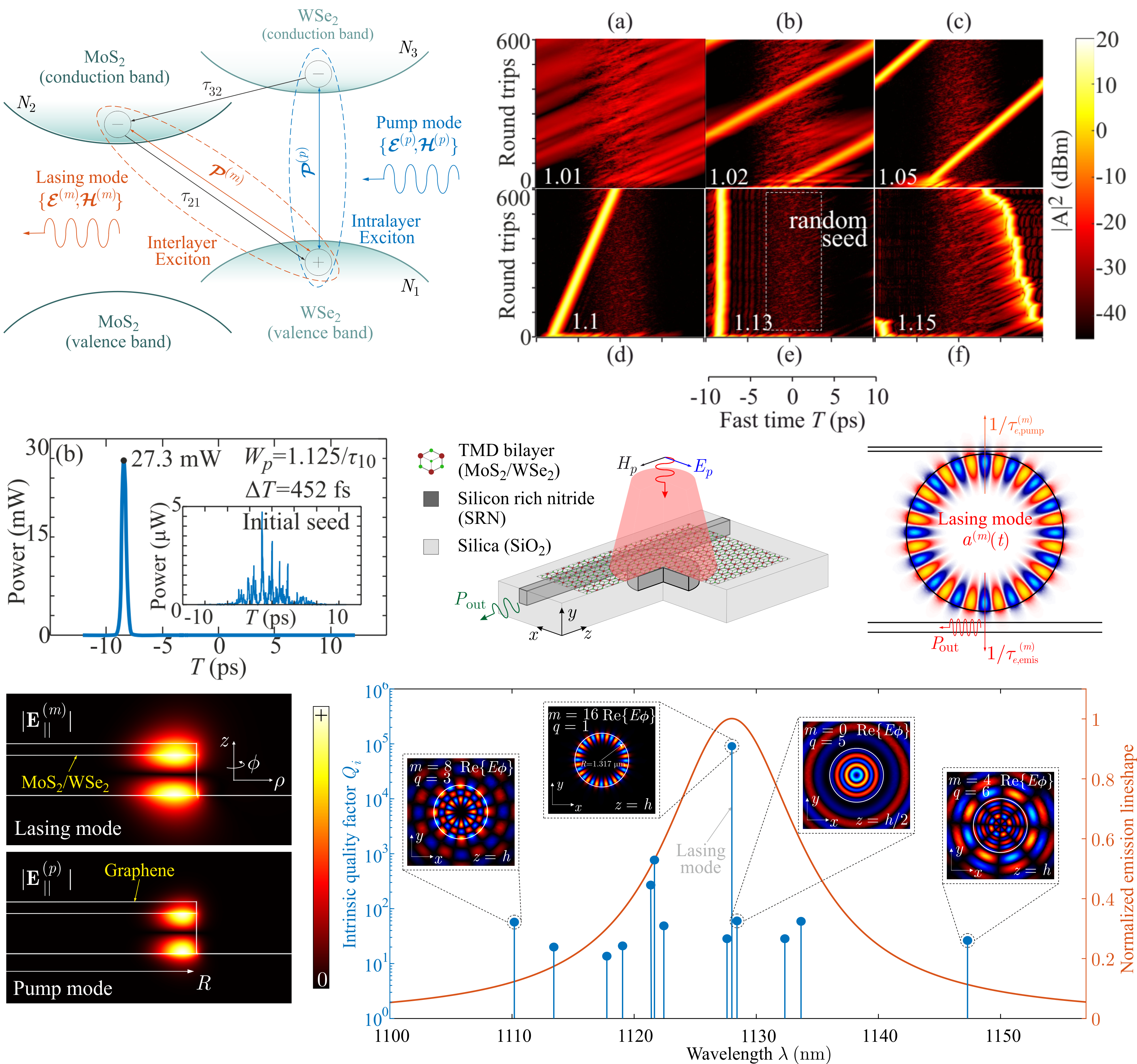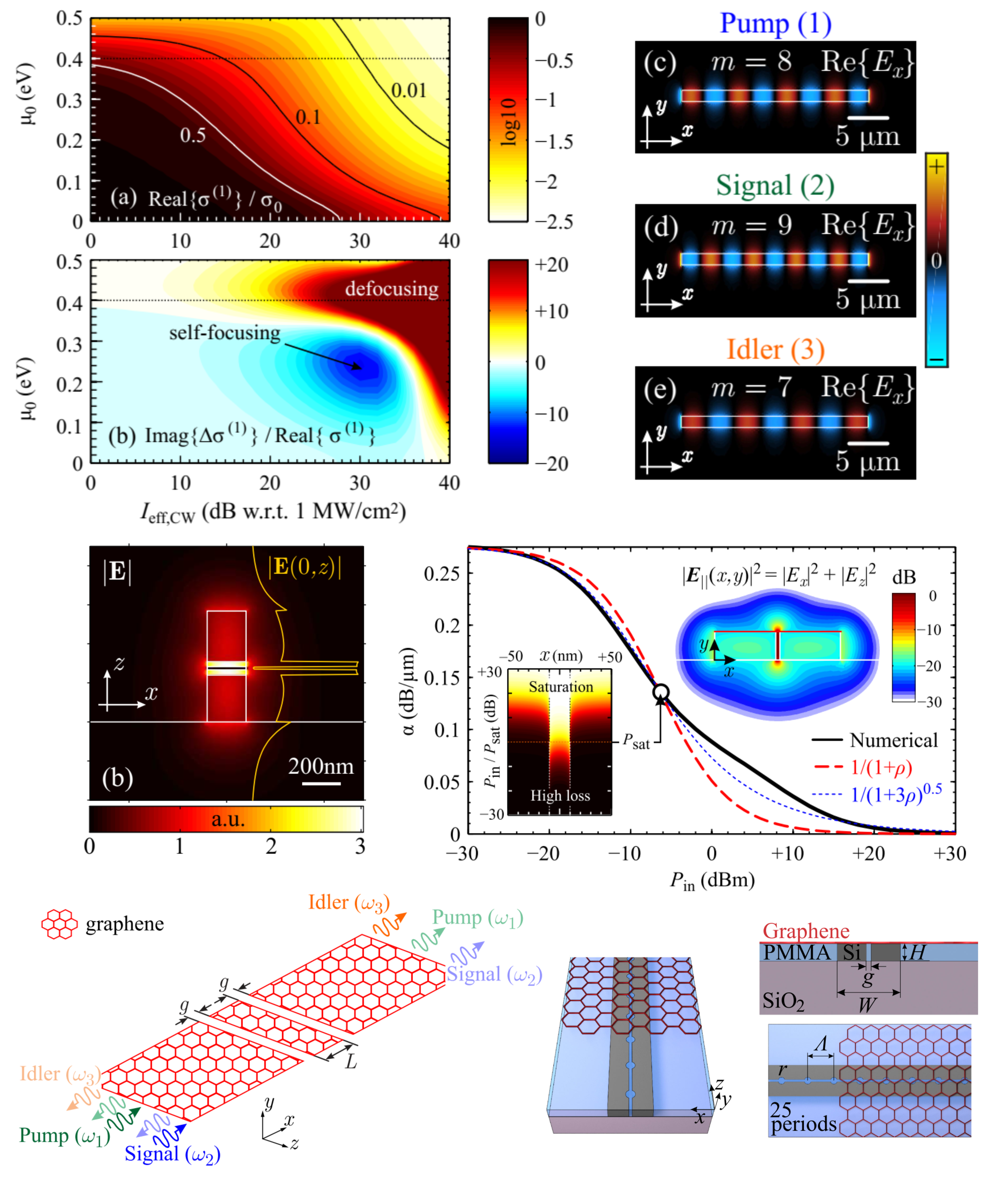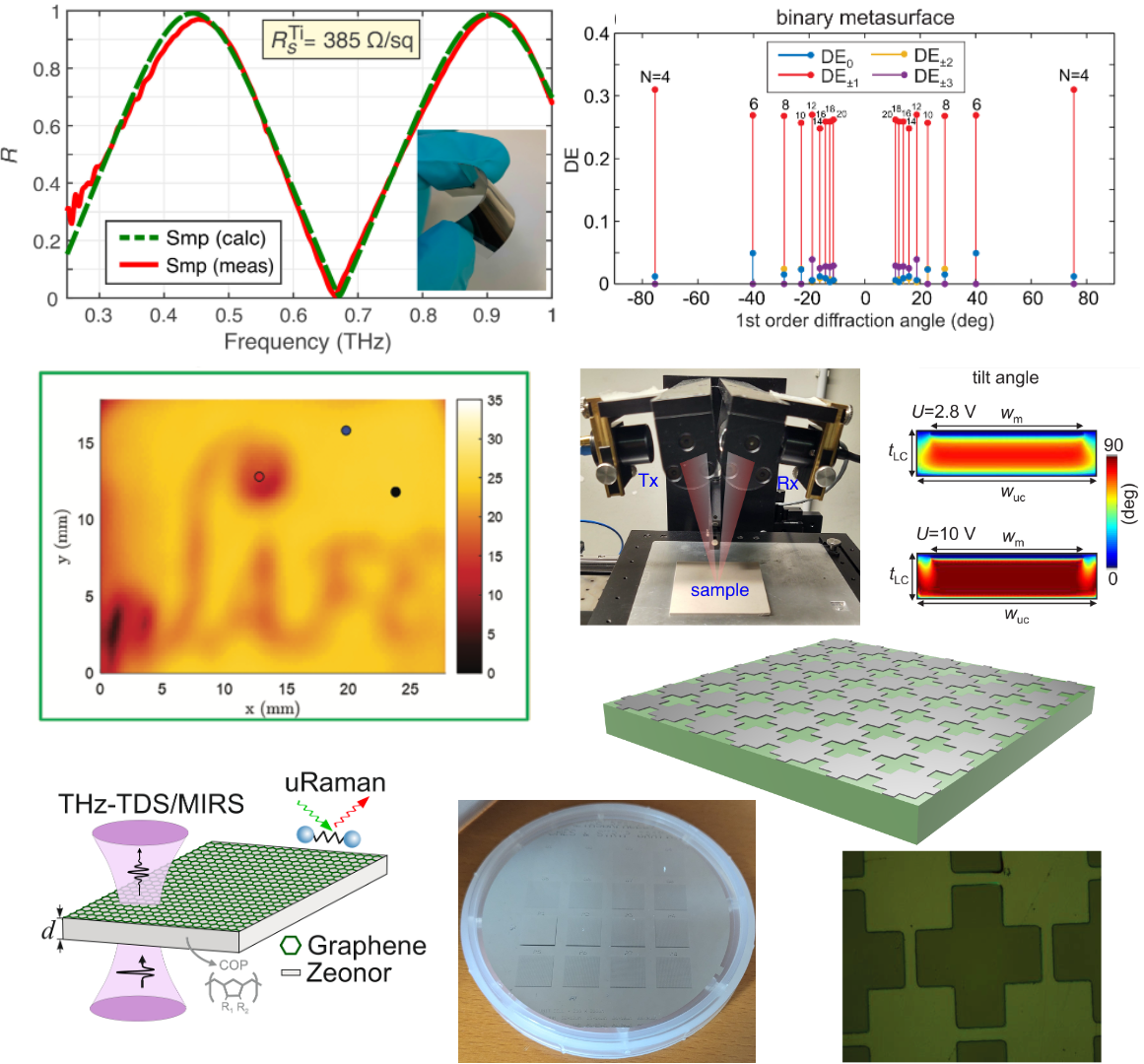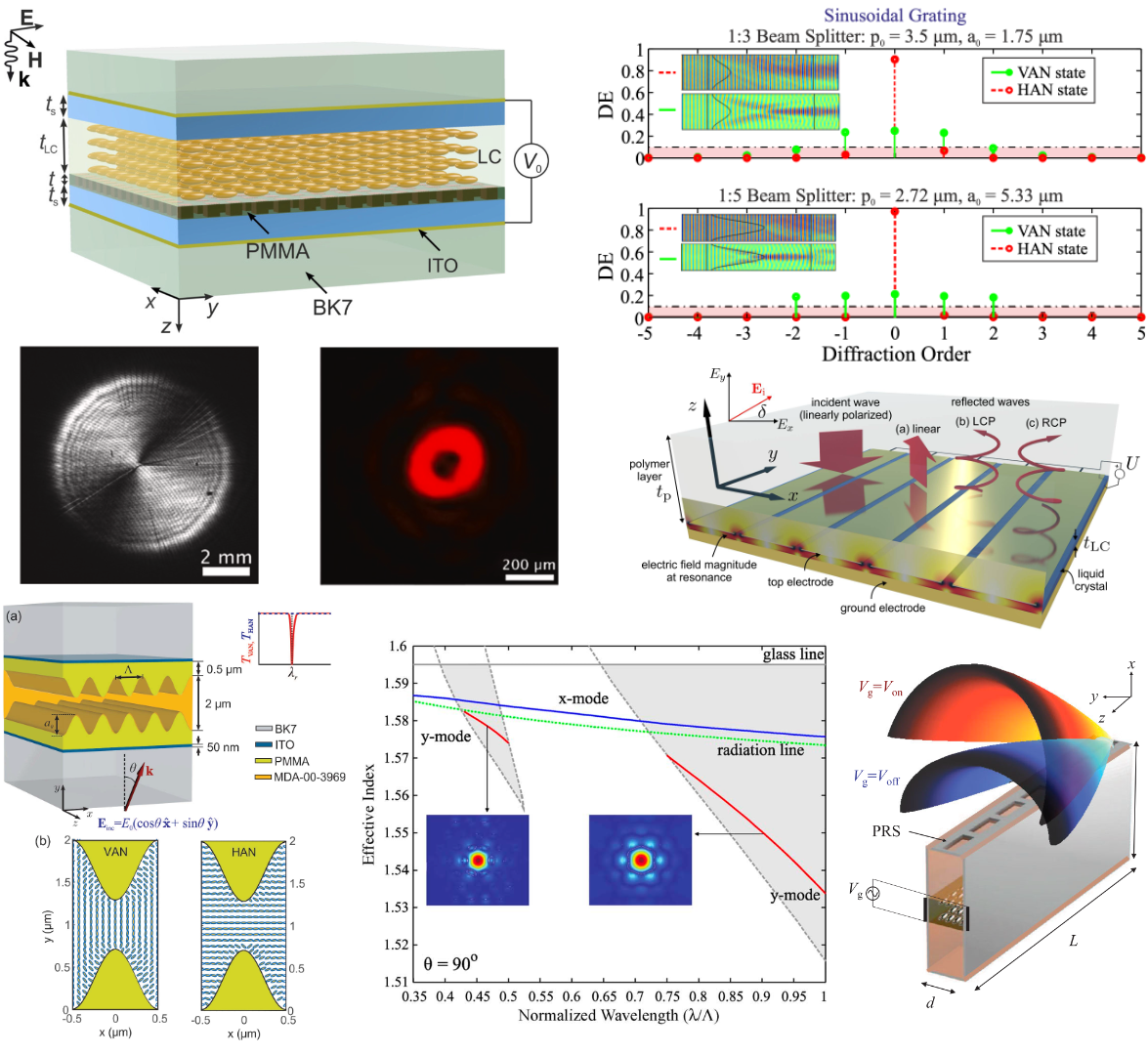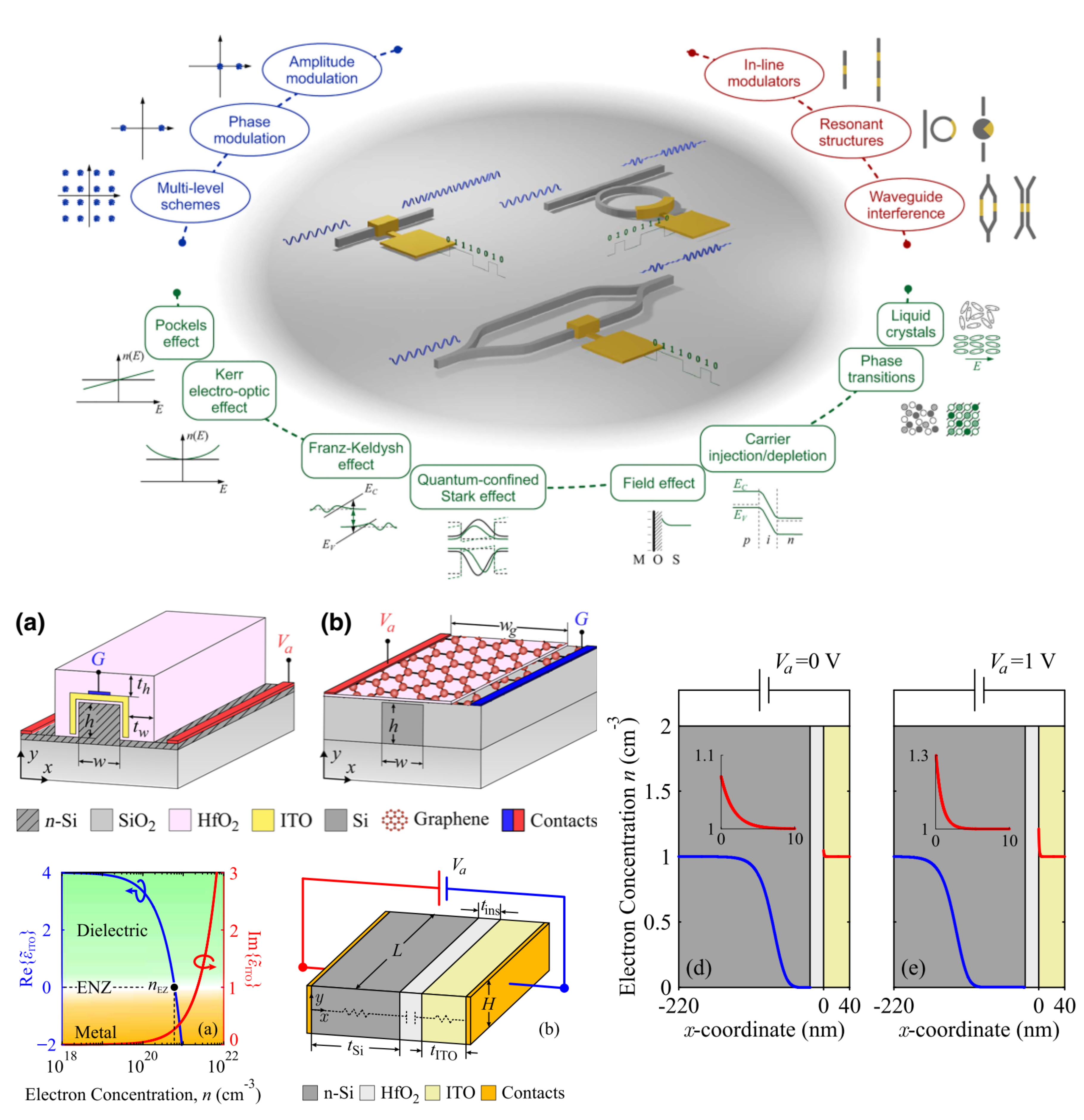Lasing nanophotonics
On-chip nanophotonic lasing sources are at the forefront of scientific research requiring novel silicon-compatible gain media integrated in nanophotonic resonators. Such promising gain materials are the two-dimensional transition metal dichalcogenides (TMDs), which emit light in the NIR and visible after being pumped either in an electrical or optical manner. Equally important for optical communication and lidar applications is to exert control over the intracavity lasing dynamics in order to achieve passively Q-switched or mode-locked operation. This additionally necessitates the integration of a highly nonlinear medium, e.g. graphene, in the lasing cavity.
Our work focuses on:
- Design of novel monolithically integrated continuous-wave (CW) and pulsed (Q-switched or mode-locked) lasing sources. The gain and nonlinear mechanisms are harnessed by contemporary 2D materials, such as TMDs and graphene.
- Accurate and efficient assessment of the overall response of the proposed lasing elements using rigorous microscopic descriptions for the optical properties of the 2D materials and the underlying bulk cavity materials.
In collaboration with TPCI-NHRF in Athens (Dr. O. Tsilipakos) and Dr. T. Christopoulos (LP2N).
Recent publications:
– D. Chatzidimitriou, G. Nousios, T. Christopoulos, and Em. E. Kriezis, “Theoretical study of a passively mode-locked integrated laser based on transition-metal dichalcogenides and graphene,” Phys. Rev. A 109, 043522 (2024).
– G. Nousios, T. Christopoulos, O. Tsilipakos, and Em. E. Kriezis, “Theoretical Analysis of Integrated Nanophotonic Q-Switched Laser Based on Gain and Saturable Absorption by Two-Dimensional Materials,” Adv. Photonics Res. 5, 2300249 (2024).
– G. Nousios, T. Christopoulos, O. Tsilipakos, and Em. E. Kriezis, “Integrated Lasers with Transition-Metal-Dichalcogenide Heterostructures: Analysis and Design Utilizing Coupled-Mode Theory for Two-Dimensional Materials,” Phys. Rev. Applied 19, 064027 (2023).
Nonlinear optics and graphene photonics
Optical nonlinear effects constitute a key mechanism for all-optical control of light and optical signal processing. The most well-researched nonlinearity emerges from the Kerr effect in semiconductors, such as silicon, as well as chalcogenide glasses and polymers. Other notable nonlinear effects in semiconductors are the two-photon absorption (TPA) effect and the free-carrier effects (FCEs). The advent of graphene, an atomically thin semimetal, has created even more scientific interest for nonlinear optics harnessing the extraordinary nonlinear properties of the material, such as the Kerr and the saturable absorption (SA) effect.
Our work focuses on the design and analysis of:
- Plasmonic and hybrid plasmonic nonlinear waveguides and resonators offering subwavelength light confinement, which boosts the light-matter interaction and the manifestation of nonlinear effects, and
- Integrated graphene-enhanced nanophotonic waveguides and resonators leveraging the low-power and ultrafast nonlinear response of graphene,
for a wide variety of applications including parametric wavelength conversion, soliton generation, as well as all-optical routing, switching, nonreciprocal, and memory elements.
In collaboration with TPCI-NHRF in Athens (Dr. O. Tsilipakos) and Dr. T. Christopoulos (LP2N).
Recent publications:
– A. Pitilakis, and Em. E. Kriezis, “Ultrafast pulse propagation in graphene-comprising nanophotonic waveguides considering nonperturbative electrodynamic nonlinearity,” J. Opt. Soc. Am B 39, 2723-2734 (2022).
– D. Chatzidimitriou, D. C. Zografopoulos, and Em. E. Kriezis, “Graphene Saturable Absorber Mirrors for Silicon Photonic Platforms,” IEEE Photonics J. 14, 2239908 (2022).
– G. Nousios, T. Christopoulos, O. Tsilipakos, and Em. E. Kriezis, “Dynamic Routing through Saturable Absorption in Graphene Photonic Resonators: Impact of Carrier Diffusion and Finite Relaxation Time,” J. Appl. Phys. 131, 053104 (2022).
– A. Pitilakis, D. Chatzidimitriou, T. V. Yioultsis, and Em. E. Kriezis, “Asymmetric Si-Slot Coupler With Nonreciprocal Response Based on Graphene Saturable Absorption,” IEEE J. Quantum Electron. 57, 8400210 (2021).
Terahertz components and spectroscopy
Terahertz science and technology are continuously expanding, providing novel solutions in numerous application areas, such as next-generation wireless communications, security, material science, quality control, and biomedicine.
Our work focuses on:
- The design and experimental characterization of planar components for THz wave manipulation, e.g., filters, polarization controllers, tunable beam steerers, and partially reflecting (meta)surfaces for antenna applications.
- Electromagnetic characterization of bulk (e.g., polymers, glasses, microwave substrates), thin conducting film (e.g., ITO, AZO, nanometric metallic layers) and 2D (e.g. graphene, graphene oxide, transition metal dichalcogenides) materials, through THz time-domain spectroscopy.
- THz imaging for quality control, non-destructive testing, and anticounterfeiting applications.
In collaboration with CNR-IMM in Rome (Dr. W. Fuscaldo, Dr. T. Ritacco), GLAB-IPB in Belgrade (Dr. G. Isić, Dr. B. Vasić), and IOMT-BAS in Sofia (Prof. V. Marinova, Prof. D. Dimitrov).
Recent publications:
– D. C. Zografopoulos et al., “Terahertz time-domain characterization of thin conducting films in reflection mode,” IEEE Trans. Antennas Propag. 72, 9301 (2024).
– T. Ritacco, D. C. Zografopoulos, S. Tofani, R. Beccherelli, and W. Fuscaldo, “Time- and frequency-domain THz imaging for the characterization of anticounterfeiting devices,” Adv. Mater. Technol. 2024, 2401799 (2024).
– W. Fuscaldo, F. Maita, L. Maiolo, R. Beccherelli, and D. C. Zografopoulos, “Broadband terahertz characterization and electromagnetic models for fishnet metasurfaces: From the homogenization to the resonant regime,” IEEE Trans. Antennas Propag. 72, 6771 (2024).
Liquid crystal photonics
Liquid crystals have been long used in the display technology leveraging their large anisotropy and reconfigurability through electrical control signals. These same properties, however, can also be exploited in the engineering of numerous other electromagnetic devices.
We work on the design of liquid-crystal based tunable components targeting various applications:
- Adaptive elements for tunable, large-aperture lensing (e.g. spherical/aspherical lenses, cylindrical/Powell lenses) and the generation of Bessel and vortex beams.
- Reconfigurable and switchable beam forming and steering devices in the near-infrared and terahertz spectrum, e.g., metasurfaces, diffraction gratings, guided-mode resonant gratings, and leaky-wave antennas.
- Tunable photonic and plasmonic guided-wave components for in-line polarization control and switching, e.g. plasmonic waveguides and couplers and liquid-crystal infiltrated photonic crystal fibers.
In collaboration with PEG-UNICAN in Santander (Dr. J. F. Algorri) and FATC-MUT in Warsaw (Prof. N. Bennis).
Recent publications:
– Walewska et al., “A hybrid trans-modal liquid crystal optical vortex generator,” Opt. Laser Technol. 181B, 111849 (2025).
– J. F. Algorri et al., “Multifunctional light beam control device by stimuli-responsive liquid crystal micro-grating structures,” Sci. Rep. 10, 13806 (2020).
– B. Vasić, G. Isić, and D. C. Zografopoulos, “Electrically tunable terahertz transmission modulators using metal-insulator-metal metasurfaces infiltrated with liquid crystals,” Opt. Mater. 151, 115377 (2024).
Light modulation and electro-optics
Integrated electro-optic modulators are indispensable parts of modern optical communication networks. Light modulation is based on a plethora of material platforms leveraging distinct physical effects in order to imprint an electrical signal upon an optical wave (carrier). During the last fifteen years, transparent conducting oxides (TCOs) have attracted immense scientific attention serving as dynamically configurable materials in electro-optics modulators, due to their unique epsilon-near-zero (ENZ) effect.
Our work focuses on:
- Design and analysis of novel integrated electro-optic modulators based on nanophotonic waveguides and resonators of the conventional silicon-on-insulator (SOI) platform enhanced with TCOs or other contemporary optoelectronic materials such as graphene.
- Development of rigorous solid-state physics frameworks for the precise calculation of the overall response and performance metrics of the electro-optic modulators.
In collaboration with Dr. G. Sinatkas (Black Semiconductor GmbH).



